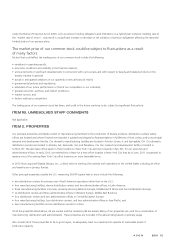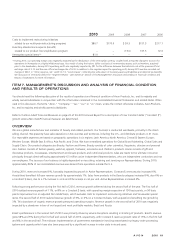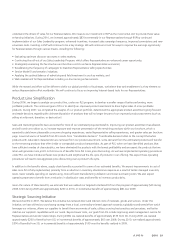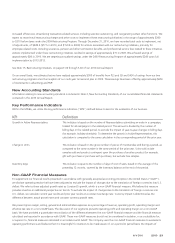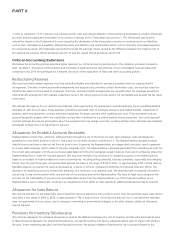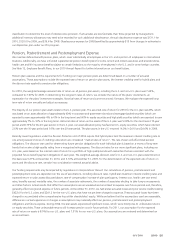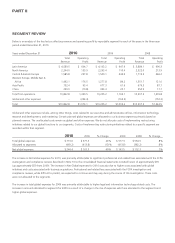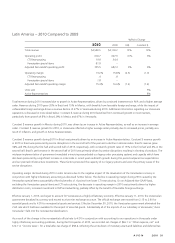Avon 2010 Annual Report Download - page 36
Download and view the complete annual report
Please find page 36 of the 2010 Avon annual report below. You can navigate through the pages in the report by either clicking on the pages listed below, or by using the keyword search tool below to find specific information within the annual report.PART II
1) costs to implement (“CTI”) restructuring initiatives and 2) costs and charges related to Venezuela being designated as a highly inflationary
economy and the subsequent devaluation of its currency in January 2010 (“Venezuelan special items”). The Venezuelan special items
include the impact on the Statement of Income caused by the devaluation of the Venezuelan currency on monetary assets and liabilities,
such as cash, receivables and payables; deferred tax assets and liabilities; and nonmonetary assets, such as inventory and prepaid expenses.
For nonmonetary assets, the Venezuelan special items include the earnings impact caused by the difference between the historical cost of
the assets at the previous official exchange rate of 2.15 and the revised official exchange rate of 4.30.
Critical Accounting Estimates
We believe the accounting policies described below represent our critical accounting policies due to the estimation processes involved in
each. See Note 1, Description of the Business and Summary of Significant Accounting Policies, of our consolidated financial statements
contained in this 2010 Annual Report for a detailed discussion of the application of these and other accounting policies.
Restructuring Reserves
We record severance-related expenses once they are both probable and estimable for severance provided under an ongoing benefit
arrangement. One-time, involuntary benefit arrangements and disposal costs, primarily contract termination costs, are recorded when the
benefits have been communicated to employees. One-time, voluntary benefit arrangements are recorded when the employee accepts the
offered benefit arrangement. We evaluate impairment issues if the carrying amount of an asset is not recoverable and exceeds the fair value
of the asset.
We estimate the expense for our restructuring initiatives, when approved by the appropriate corporate authority, by accumulating detailed
estimates of costs for such plans. These expenses include the estimated costs of employee severance and related benefits, impairment of
property, plant and equipment, contract termination payments for leases, and any other qualifying exit costs. These estimated costs are
grouped by specific projects within the overall plan and are then monitored on a quarterly basis by finance personnel. Such costs represent
our best estimate, but require assumptions about the programs that may change over time, including attrition rates. Estimates are evaluated
periodically to determine if an adjustment is required.
Allowances for Doubtful Accounts Receivable
Representatives contact their customers, selling primarily through the use of brochures for each sales campaign. Sales campaigns are
generally for a two-week duration in the U.S. and a two- to four-week duration outside the U.S. The Representative purchases products
directly from us and may or may not sell them to an end user. In general, the Representative, an independent contractor, remits a payment
to us each sales campaign, which relates to the prior campaign cycle. The Representative is generally precluded from submitting an order for
the current sales campaign until the accounts receivable balance for the prior campaign is paid; however, there are circumstances where the
Representative fails to make the required payment. We record an estimate of an allowance for doubtful accounts on receivable balances
based on an analysis of historical data and current circumstances, including selling schedules, business operations, seasonality and changing
trends. Over the past three years, annual bad debt expense has been in the range of $195 to $222, or approximately 2.0% of total revenue.
Bad debt expense, as a percent of revenue decreased by .2 points in 2010 as compared to 2009 due to improved collection efforts. The
allowance for doubtful accounts is reviewed for adequacy, at a minimum, on a quarterly basis. We generally have no detailed information
concerning, or any communication with, any end user of our products beyond the Representative. We have no legal recourse against the
end user for the collectability of any accounts receivable balances due from the Representative to us. If the financial condition of our
Representatives were to deteriorate, resulting in an impairment of their ability to make payments, additional allowances may be required.
Allowances for Sales Returns
We record a provision for estimated sales returns based on historical experience with product returns. Over the past three years, sales returns
have been in the range of $365 to $425, or approximately 3.7% of total revenue. If the historical data we use to calculate these estimates
does not approximate future returns, due to changes in marketing or promotional strategies, or for other reasons, additional allowances
may be required.
Provisions for Inventory Obsolescence
We record an allowance for estimated obsolescence equal to the difference between the cost of inventory and the estimated market value.
In determining the allowance for estimated obsolescence, we classify inventory into various categories based upon its stage in the product
life cycle, future marketing sales plans and the disposition process. We assign a degree of obsolescence risk to products based on this



